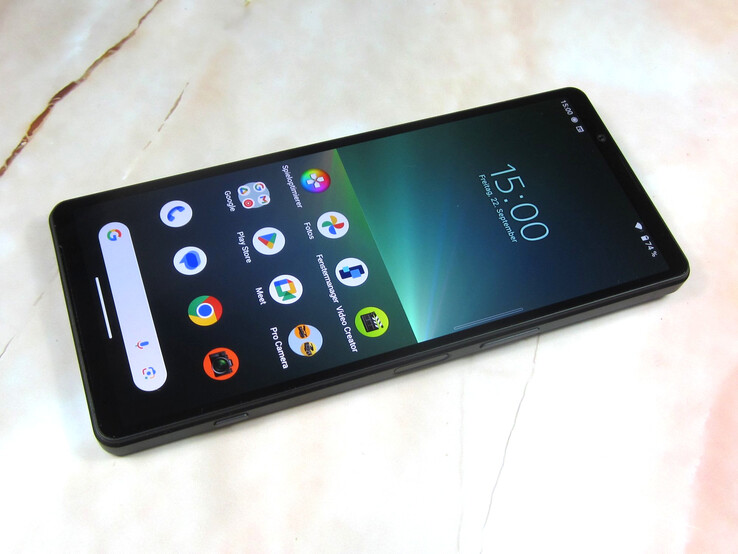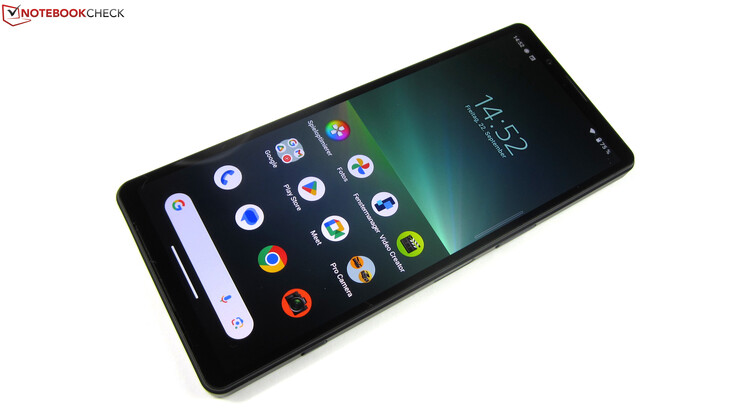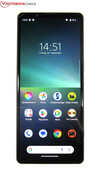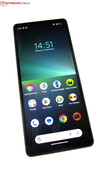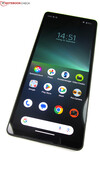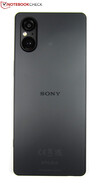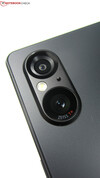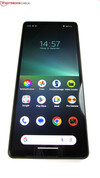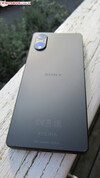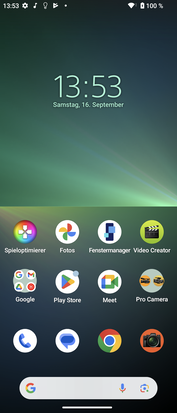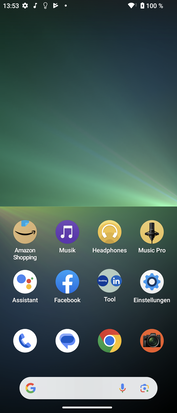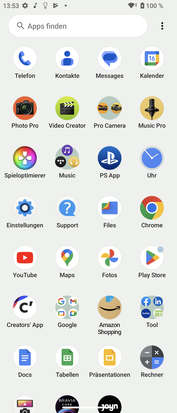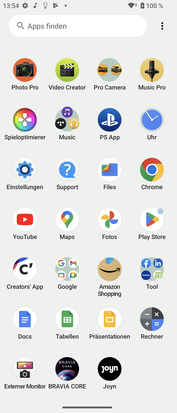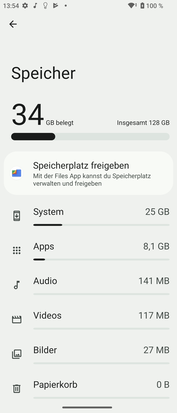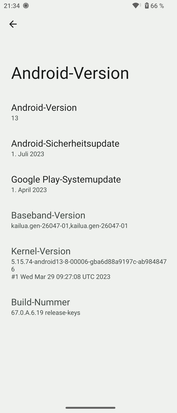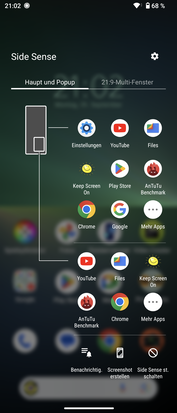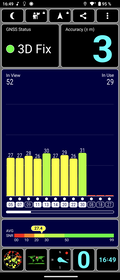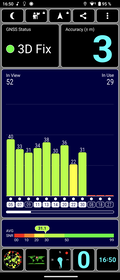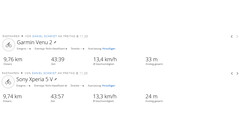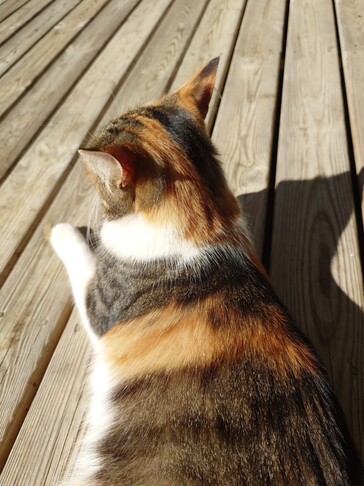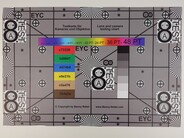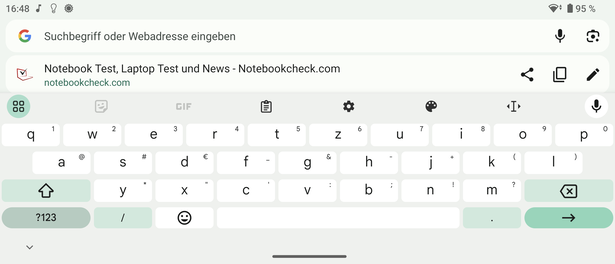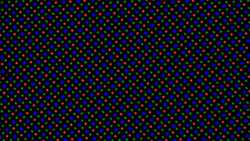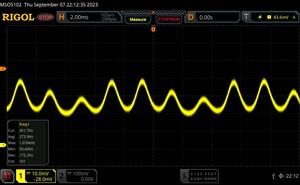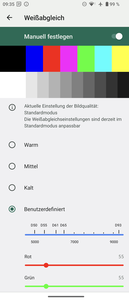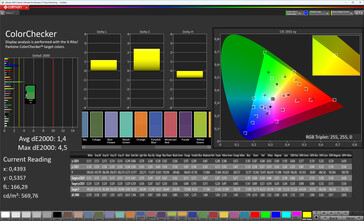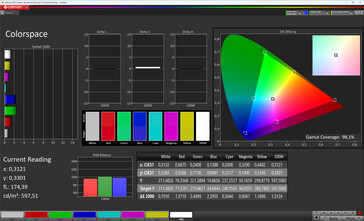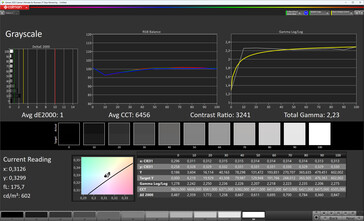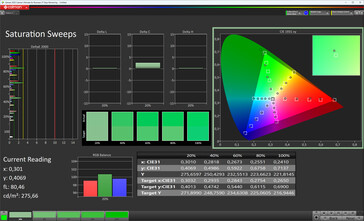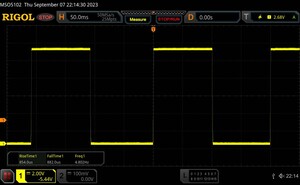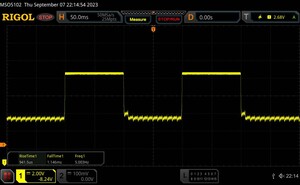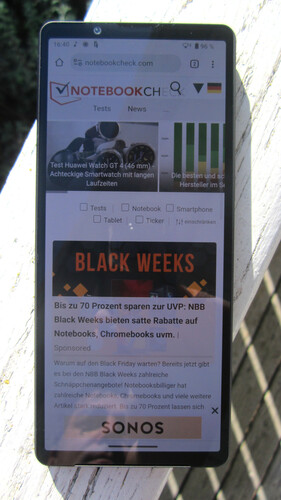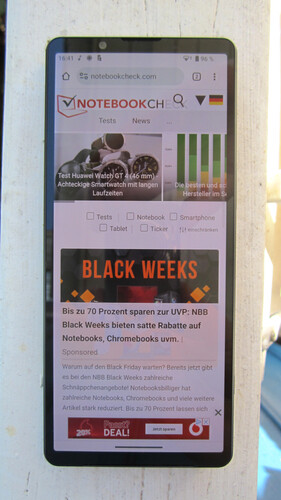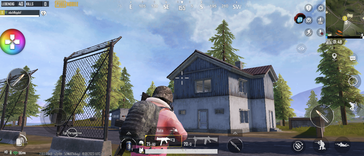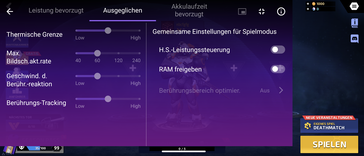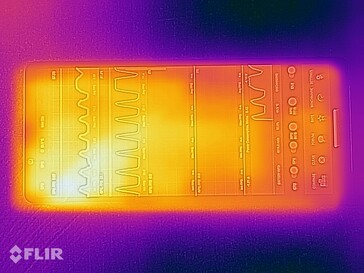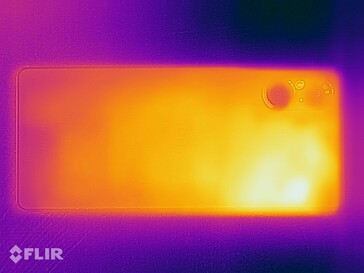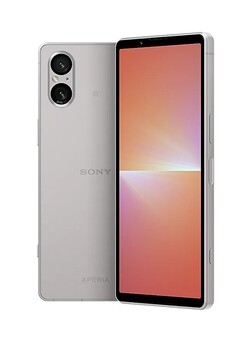Sony Xperia 5 V review: Compact premium smartphone with professional camera
With the Xperia 5 V, Sony's current Xperia lineup is now complete. In the Xperia hierarchy, the smartphone ranks directly behind top model Xperia 1 V that costs around US$ 1100. Therefore, the Xperia 1 V, officially priced at 999 Euros (~ US$999), also offers high-end features that you would not necessarily expect due to the small form factor.
The Xperia 5 V takes an unusual path, thus striking a similar tone to its Xperia 5 IV predecessor: at a size of 6.1 inches and a slim 21:9 display format, our test unit comes across as a classy and compact smartphone that is equipped with very powerful hardware. The high-end Snapdragon 8 Gen 2 is accompanied by a strong battery life and a camera configuration aimed at photo enthusiasts in particular.
Possible competitors in comparison
Rating | Date | Model | Weight | Drive | Size | Resolution | Price |
|---|---|---|---|---|---|---|---|
| 89 % v7 (old) | 09 / 2023 | Sony Xperia 5 V SD 8 Gen 2, Adreno 740 | 182 g | 128 GB UFS 3.1 Flash | 6.10" | 2520x1080 | |
| 89.2 % v7 (old) | 10 / 2022 | Apple iPhone 14 A15, A15 GPU 5-Core | 172 g | 128 GB NVMe | 6.10" | 2532x1170 | |
| 89.1 % v7 (old) | 11 / 2022 | Google Pixel 7 Pro Tensor G2, Mali-G710 MP7 | 212 g | 128 GB UFS 3.1 Flash | 6.70" | 3120x1440 | |
| 90.3 % v7 (old) | 03 / 2023 | Samsung Galaxy S23+ SD 8 Gen 2 for Galaxy, Adreno 740 | 195 g | 256 GB UFS 4.0 Flash | 6.60" | 2340x1080 | |
| 89.2 % v7 (old) | 12 / 2022 | Sony Xperia 5 IV SD 8 Gen 1, Adreno 730 | 171 g | 128 GB UFS 3.1 Flash | 6.10" | 2520x1080 | |
| 89.1 % v7 (old) | 02 / 2023 | Xiaomi 13 SD 8 Gen 2, Adreno 740 | 189 g | 256 GB UFS 4.0 Flash | 6.36" | 2400x1080 |
Case - Slim 21:9 chassis out of glass and metal
Compared to the Xperia 5 IV, Sony has hardly changed anything in the design of its premium smartphone. The Xperia 5 V also makes use of an elongated case with a 21:9 aspect ratio and almost unchanged dimensions. The weight has increased from 171 to 182 grams.
Thanks to its slim build, the Xperia 5 V fits well in the hand and feels high-quality all around. Both the display and the back are protected by Gorilla Glass Victus 2 and are connected to each other by a metal frame. The surface of the matte back cover is smooth, but offers some finger resistance due to its light rubber coating.
The side edges, which are slightly thicker than other upper-range devices, may not be appreciated by some. In return, the Xperia 5 V does without a punchhole or notch for the selfie camera, which is integrated unobtrusively into the display frame.
The microSD/SIM slot, which is equipped with a rubber seal, can be opened without tools. Available in black, blue and silver for US$909, the Xperia 5 V is IP65 and IP68 certified.
Equipment - USB-C 3.2 Gen.1 and always-on display
Sony offers the Xperia 5 V with 128 GB of internal storage. This can be expanded via the microSD slot, which holds cards up to 1 TB in size. The microSD card can also be formatted in exFAT file format.
Other interfaces include a 3.5 millimeter jack port, which is located on the top of the device. The OTG-capable USB-C port works at USB-C 3.2 Gen.1 speed and has a nominal transfer speed of 5 Gbit/s. NFC is also integrated.
Unlike its predecessor the Xperia 5 V no longer has a notification LED. What remains, however, is the optionally activated always-on display, which shows the date, time and battery status as well as new notifications.
microSD card reader
We tested the transfer speed of the microSD port using our Angelbird AV Pro V60 microSD reference card. The sequential data transfers are mediocre and sometimes below those of the Xperia 5 IV. In the copy test, our test device is able to surpass its predecessor, but is still quite slow at 20.6 MB/s.
The smartphone performs better in the USB copy test. The Xperia 5 V achieves a USB transfer rate of 180.18 MB/s with the Samsung 980 Pro SSD in Asus' ROG Strix Arion Case, which is connected via USB 3.2 Gen.2.
| SD Card Reader - average JPG Copy Test (av. of 3 runs) | |
| Sony Xperia 5 V (Angelbird AV Pro V60) | |
| Sony Xperia 5 IV (Angelbird AV Pro V60) | |
Cross Platform Disk Test (CPDT)
Software - Android 13 and 3 years of updates
The Xperia 5 V runs Android 13, which Sony has largely left in its original state. But there are a few additional features on board.
The Side Sense feature allows the opening of one app in a pop-up window before another. Displaying two apps simultaneously in a multi-window view is also possible. Both functions are accessible via the Window Manager app as well as directly via a transparent, narrow button located on the right edge of the screen.
Another additional feature is the Game Optimizer, an app that launches automatically when you start a game and remains there as a small circular icon or alternatively as a pull-down bar. The Game Optimizer gives you access to the performance-, display- and streaming settings, and can hide notifications.
A few third-party apps such as Amazon, Facebook and LinkedIn also come preinstalled. Upon formatting the smartphone, only 94 GB of the 128 GB is free because the OS package takes up a whopping 34 GB. DRM Widevine L1 for HD streaming is supported.
Sony promises two Android upgrades and three years of Android security updates for its smartphone. This is not much compared to other upper-class smartphones, since manufacturers usually provide updates for 5 years in this price range.
Communication and GNSS - Xperia 5 V with WiFi 6E
The Xperia 5 V covers 24 4G and 11 5G frequencies and supports WiFi 6E in addition to NFC and Bluetooth 5.3. In tandem with our Asus ROG Rapture GT-AXE11000 reference router, the smartphone achieves fast and stable Wi-Fi transfer rates.
Overall, however, the Xperia 5 V falls short of its potential because it did not recognize the 6 GHz network in testing, which hindered even higher transfer rates. We hope Sony will improve this with an update.
| Networking | |
| Sony Xperia 5 V | |
| iperf3 receive AXE11000 | |
| iperf3 transmit AXE11000 | |
| Apple iPhone 14 | |
| iperf3 receive AXE11000 | |
| iperf3 transmit AXE11000 | |
| Google Pixel 7 Pro | |
| iperf3 receive AXE11000 | |
| iperf3 transmit AXE11000 | |
| iperf3 transmit AXE11000 6GHz | |
| iperf3 receive AXE11000 6GHz | |
| Samsung Galaxy S23+ | |
| iperf3 receive AXE11000 | |
| iperf3 transmit AXE11000 | |
| iperf3 transmit AXE11000 6GHz | |
| iperf3 receive AXE11000 6GHz | |
| Sony Xperia 5 IV | |
| iperf3 receive AXE11000 | |
| iperf3 transmit AXE11000 | |
| iperf3 transmit AXE11000 6GHz | |
| iperf3 receive AXE11000 6GHz | |
| Xiaomi 13 | |
| iperf3 receive AXE11000 | |
| iperf3 transmit AXE11000 | |
| iperf3 transmit AXE11000 6GHz | |
| iperf3 receive AXE11000 6GHz | |
| Average of class Smartphone | |
| iperf3 receive AXE11000 | |
| iperf3 transmit AXE11000 | |
| iperf3 transmit AXE11000 6GHz | |
| iperf3 receive AXE11000 6GHz | |
Sony's smartphone pinpoints its location via the GPS (L1), Glonass (L1), Galileo (L1), Beidou (B1, B1C) and QZSS satellite navigation systems. In testing, the Xperia 5 V was able to locate satellites quickly and at an accuracy of 3 meters both indoors and outdoors.
The Xperia 5 V passed our real-world GPS test with flying colors, proving its suitability for navigational tasks in everyday life. The Sony tracked our almost 10 kilometer long bike route almost as precisely as the Garmin Venu2 fitness smartwatch.
Telephony and voice quality - Xperia 5 V with eSIM
The Xperia 5 V delivers very good voice quality. During our test calls, all our call partners attested to clear sound that is largely free of background noise. Sound quality remains good in hands-free mode.
In addition to VoLTE, the smartphone also supports Wi-Fi calls and dual SIM. Only a physical nano SIM card fits into the card slot, which can be opened without a SIM tool. Dual operation can then be set up using an eSIM.
Cameras - Dual camera with 3 focal lengths and sensor zoom
Just like the Sony Xperia 5 IV, Sony is once again cooperating with lens specialist Zeiss for the Xperia V 5, but utilizes a revised camera system that clearly differs from the predecessor.
The number of lenses on the back has been reduced from 3 to 2, but there are still 3 focal lengths (16, 24 & 48 mm), which might not really fit together at first. This apparent contradiction is resolved by the new main camera, which works with two different focal lengths, depending on the shooting situation.
Sony also used a triple camera for the Xperia 5 IV, which consists of a 12 MP main, ultra-wide-angle and telephoto camera. In the successor, the Xperia 5 V, the ultra-wide-angle camera still has a resolution of 12 MP (Sony Exmor RS, 1/2.5", f/2.2, 16 mm), but the telephoto camera has been dropped. However, this is not entirely without replacement because its functionality has been taken over by the main camera.
The main camera of the Xperia 5 V uses the Sony Exmor T IMX 888 (1/1.35", f/1.9, OIS), which is the same sensor used in the current Xperia flagship, the Sony Xperia 1 V. Our test unit also does not utilize the full 52 MP, but only a section of it with a maximum of 48 MP to simulate a 48 MP telephoto lens.
When taking photos, the main camera uses a focal length of 24 mm and creates 12 MP photos via 4x pixel binning. If you use the software at the standard setting of 2x, the main camera switches to a focal length of 48 mm and thus simulates an optical zoom with virtually no loss of quality. The digital magnification works in increments of 0.1 up to a maximum of 6x.
We recorded our test shots in the automatic mode of the standard camera software Photo Pro, which offers extensive setting options. Continuous shooting is possible at up to 30 frames per second, RAW shooting is supported, and the camera can automatically focus on and track the face or eyes of people and animals in portrait shots.
In our tests, the main camera delivers very good image quality. In daylight, photos are nice and sharp and fine details are clearly visible, even in darker subject areas. The images are also distinguished by a pleasantly natural coloration that is not as strong as in many competing models, such as Samsung.
The software telephoto zoom is also impressive at small zoom levels, but quickly reaches its limits at more than 2x magnification. The Xperia 5 V does a much better job than the Xperia 5 IV in night shots due to its larger main sensor.
The main camera records videos in convincing quality in 4K at 120 frames per second. However, users who want to use the software zoom have to lower the frame rate to 60 FPS. Sony provides two preinstalled apps for video editing: Video Pro and Camera Pro.
Apart from the main camera, the Xperia 5 V offers solid standard fare. Photos taken by the ultra-wide-angle camera are pleasing due to their neutral color representation and show a lot of detail, but are always slightly noisy, especially at the edges and corners, even in optimal lighting conditions. The 12 MP selfie camera takes good, sharp shots in daylight with an attractive bokeh effect and can record videos in 4K at 60 frames per second.
Image comparison
Choose a scene and navigate within the first image. One click changes the position on touchscreens. One click on the zoomed-in image opens the original in a new window. The first image shows the scaled photograph of the test device.
Daylight photo 1Daylight photo 2Ultra wide angle5x zoomLow lightWe took another close look at the main camera in the test lab. In optimal lighting conditions, the Xperia 5 V captures colors quite accurately (maximum Delta-E of 12.09) and displays the test chart sharply. At 1 lux residual light the chart is still completely visible, but also blurry.
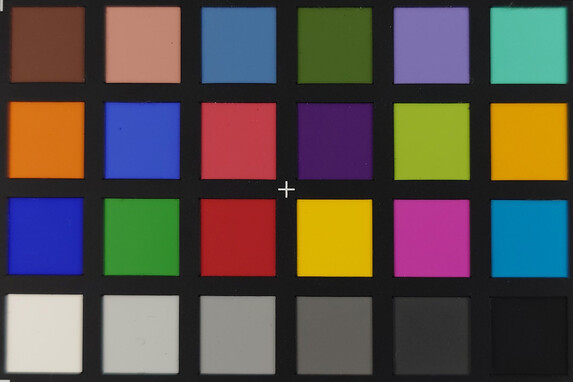
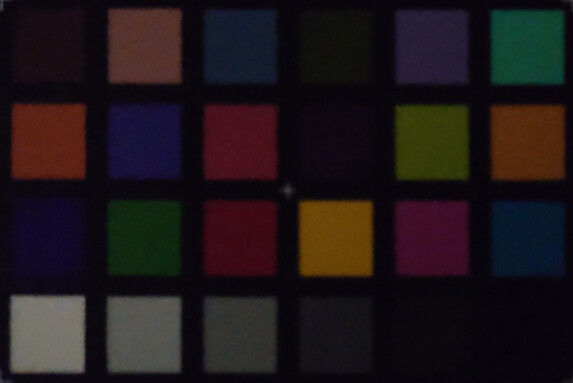
Accessories and warranty - Neither power supply nor USB cable
Sony is very restrained in the Sony Xperia 5 V's scope of delivery. Neither a power supply nor a USB cable are included. Only a quick start guide and a few other booklets with safety instructions and SAR information are provided.
Sony's web store offers a lot of accessories for the smartphone. In addition to products such as protective cases, Bluetooth headsets, chargers and adapter cables, there is also a holder (including a mini-display) that allows content creators to use the Xperia 5 V as a vlogging device.
Sony offers a 24-month warranty for the Xperia 5 V in Germany. This may differ in other regions, so buyers should double check before purchasing.
Input devices & operation - Fast fingerprint reader, but no Face Unlock
The capacitive touchscreen of the Xperia 5 V works at a sampling rate of 240 Hz, responds very quickly to inputs and has excellent gliding properties.
The smartphone can be unlocked biometrically via the fingerprint sensor integrated into the power button, which also works smoothly when the display is turned off. The Xperia 5 V can remain unlocked via the Smart Lock function as long as you carry it with you or use it in a safe place such as your own home.
Due to the high display resolution of 2560 x 1080, icons, fonts and screen elements are displayed very sharply, but are also quite small. If necessary, the display size can be adjusted in 4 levels in the Android settings. The default setting is level 2, so there is still some room for improvement.
Another input aid is the one-hand mode, which makes sense for people with large hands because the Xperia 5 V is sometimes difficult to use with one hand due to its elongated 21:9 aspect ratio.
Display - Bright OLED panel with 120 Hz
The 6.1-inch OLED panel of the Xperia 5 V has a resolution of 2520 x 1080, which corresponds to a high pixel density of 449 PPI. The refresh rate can be set to either 120 or 60 Hz. There is no dynamic adjustment of the refresh rate in Sony's smartphone, nor on the Xperia 1 V flagship.
We recorded a very good maximum brightness of 912 cd/m² with the brightness sensor enabled. On average, the OLED panel manages almost 900 cd/m², which is practically as bright as the Xperia 5 IV. The Xperia 5 V increases up to 1295 cd/m² with HDR content - HDR10 and HLG are supported. A maximum of 596 cd/m² is possible when the brightness sensor is disabled. We measured 1.84 cd/m² at the lowest brightness level.
The display flickers in a PWM frequency range of 120 to 274 Hz. The flickering occurs across the entire brightness spectrum and is quite high-frequency. This may be cause for complaint among sensitive users.
| |||||||||||||||||||||||||
Brightness Distribution: 97 %
Center on Battery: 889 cd/m²
Contrast: ∞:1 (Black: 0 cd/m²)
ΔE ColorChecker Calman: 1.4 | ∀{0.5-29.43 Ø4.78}
ΔE Greyscale Calman: 1 | ∀{0.09-98 Ø5}
100% sRGB (Calman 2D)
Gamma: 2.23
CCT: 6456 K
| Sony Xperia 5 V OLED, 2520x1080, 6.1" | Apple iPhone 14 OLED, 2532x1170, 6.1" | Google Pixel 7 Pro OLED, 3120x1440, 6.7" | Samsung Galaxy S23+ Dynamic AMOLED 2x, 2340x1080, 6.6" | Sony Xperia 5 IV OLED, 2520x1080, 6.1" | Xiaomi 13 OLED, 2400x1080, 6.4" | |
|---|---|---|---|---|---|---|
| Screen | -18% | 18% | -33% | -19% | 2% | |
| Brightness middle (cd/m²) | 889 | 835 -6% | 1022 15% | 1128 27% | 896 1% | 1209 36% |
| Brightness (cd/m²) | 898 | 841 -6% | 1025 14% | 1136 27% | 902 0% | 1208 35% |
| Brightness Distribution (%) | 97 | 97 0% | 99 2% | 99 2% | 97 0% | 98 1% |
| Black Level * (cd/m²) | ||||||
| Colorchecker dE 2000 * | 1.4 | 1.05 25% | 0.9 36% | 2.7 -93% | 2 -43% | 1.2 14% |
| Colorchecker dE 2000 max. * | 4.5 | 2.81 38% | 2.1 53% | 4.5 -0% | 6.4 -42% | 3 33% |
| Greyscale dE 2000 * | 1 | 2.6 -160% | 1.1 -10% | 2.6 -160% | 1.3 -30% | 2.1 -110% |
| Gamma | 2.23 99% | 2.034 108% | 2.22 99% | 2.05 107% | 2.25 98% | 2.26 97% |
| CCT | 6456 101% | 6616 98% | 6650 98% | 6644 98% | 6618 98% | 6504 100% |
* ... smaller is better
Screen Flickering / PWM (Pulse-Width Modulation)
| Screen flickering / PWM detected | 274 Hz | ||
The display backlight flickers at 274 Hz (worst case, e.g., utilizing PWM) . The frequency of 274 Hz is relatively high, so most users sensitive to PWM should not notice any flickering. However, there are reports that some users are still sensitive to PWM at 500 Hz and above, so be aware. In comparison: 53 % of all tested devices do not use PWM to dim the display. If PWM was detected, an average of 8108 (minimum: 5 - maximum: 343500) Hz was measured. | |||
Series of measurements at a fixed zoom level and different brightness settings
The OLED panel of the Xperia 5 V reproduces colors very naturally in the default picture mode, which can be further optimized with our display settings for the white balance (see screenshot). In the ColorChecker analysis with CalMan, there is only a larg outlier for a shade of green, but this does not detract from a very solid impression overall.
Display Response Times
| ↔ Response Time Black to White | ||
|---|---|---|
| 1.74 ms ... rise ↗ and fall ↘ combined | ↗ 0.854 ms rise | |
| ↘ 0.882 ms fall | ||
| The screen shows very fast response rates in our tests and should be very well suited for fast-paced gaming. In comparison, all tested devices range from 0.1 (minimum) to 240 (maximum) ms. » 9 % of all devices are better. This means that the measured response time is better than the average of all tested devices (20.2 ms). | ||
| ↔ Response Time 50% Grey to 80% Grey | ||
| 2.09 ms ... rise ↗ and fall ↘ combined | ↗ 0.9415 ms rise | |
| ↘ 1.146 ms fall | ||
| The screen shows very fast response rates in our tests and should be very well suited for fast-paced gaming. In comparison, all tested devices range from 0.165 (minimum) to 636 (maximum) ms. » 9 % of all devices are better. This means that the measured response time is better than the average of all tested devices (31.6 ms). | ||
Performance - Lots of SoC power for the small Xperia 5 V
The compact Xperia 5 V is equipped with the Snapdragon 8 Gen 2, one of the fastest SoCs for Android smartphones. Sony's device thus performs at top tier level in testing and offers more than enough performance for everyday use. However, the same can be said for the Xperia 5 IV, which is anything but slow with its Snapdragon 8 Gen 1.
In the synthetic benchmarks, the Xperia 5 V is on par with the Xiaomi 13, which also uses the Snapdragon 8 Gen 2. Only the Apple iPhone 14 with its Apple A15 Bionic chip and the Samsung Galaxy S23+ are faster among the comparison devices. The latter because its Snapdragon 8 Gen 2 for Galaxy works with a 160 MHz higher clocked prime core compared with the Snapdragon 8 Gen 2 and thus has a small performance advantage.
| UL Procyon AI Inference for Android - Overall Score NNAPI | |
| Sony Xperia 5 IV | |
| Google Pixel 7 Pro | |
| Average of class Smartphone (3769 - 81594, n=136, last 2 years) | |
| Samsung Galaxy S23+ | |
| Sony Xperia 5 V | |
| Xiaomi 13 | |
| Average Qualcomm Snapdragon 8 Gen 2 (11338 - 16880, n=21) | |
The Snapdragon 8 Gen 2's Adreno 740 gives the Xperia 5 V plenty of GPU power. In the graphics benchmarks, the smartphone takes the top spot in the test field together with its Snapdragon 8 Gen 2 counterparts Samsung Galaxy S23+ and Xiaomi 13. Its 120 Hz panel gives it a clear lead in the onscreen tests over the Apple iPhone 14, which is limited to 60 Hz.
GFXBench (DX / GLBenchmark) 2.7: T-Rex Onscreen | 1920x1080 T-Rex Offscreen
GFXBench 3.0: on screen Manhattan Onscreen OGL | 1920x1080 1080p Manhattan Offscreen
GFXBench 3.1: on screen Manhattan ES 3.1 Onscreen | 1920x1080 Manhattan ES 3.1 Offscreen
GFXBench: on screen Car Chase Onscreen | 1920x1080 Car Chase Offscreen | on screen Aztec Ruins High Tier Onscreen | 2560x1440 Aztec Ruins High Tier Offscreen | on screen Aztec Ruins Normal Tier Onscreen | 1920x1080 Aztec Ruins Normal Tier Offscreen | 3840x2160 4K Aztec Ruins High Tier Offscreen
| 3DMark / Wild Life Extreme Unlimited | |
| Xiaomi 13 | |
| Sony Xperia 5 V | |
| Samsung Galaxy S23+ | |
| Apple iPhone 14 | |
| Sony Xperia 5 IV | |
| Google Pixel 7 Pro | |
| 3DMark / Wild Life Extreme | |
| Samsung Galaxy S23+ | |
| Xiaomi 13 | |
| Sony Xperia 5 V | |
| Apple iPhone 14 | |
| Sony Xperia 5 IV | |
| Google Pixel 7 Pro | |
| 3DMark / Wild Life Unlimited Score | |
| Samsung Galaxy S23+ | |
| Xiaomi 13 | |
| Sony Xperia 5 V | |
| Apple iPhone 14 | |
| Sony Xperia 5 IV | |
| Google Pixel 7 Pro | |
| 3DMark / Sling Shot Extreme (ES 3.1) Unlimited Physics | |
| Sony Xperia 5 V | |
| Samsung Galaxy S23+ | |
| Google Pixel 7 Pro | |
| Xiaomi 13 | |
| Sony Xperia 5 IV | |
| Apple iPhone 14 | |
| 3DMark / Sling Shot Extreme (ES 3.1) Unlimited Graphics | |
| Xiaomi 13 | |
| Samsung Galaxy S23+ | |
| Sony Xperia 5 V | |
| Sony Xperia 5 IV | |
| Google Pixel 7 Pro | |
| Apple iPhone 14 | |
| 3DMark / Sling Shot Extreme (ES 3.1) Unlimited | |
| Sony Xperia 5 V | |
| Samsung Galaxy S23+ | |
| Xiaomi 13 | |
| Sony Xperia 5 IV | |
| Google Pixel 7 Pro | |
| Apple iPhone 14 | |
| GFXBench (DX / GLBenchmark) 2.7 / T-Rex Onscreen | |
| Google Pixel 7 Pro | |
| Xiaomi 13 | |
| Samsung Galaxy S23+ | |
| Sony Xperia 5 V | |
| Sony Xperia 5 IV | |
| Apple iPhone 14 | |
| GFXBench (DX / GLBenchmark) 2.7 / T-Rex Offscreen | |
| Samsung Galaxy S23+ | |
| Sony Xperia 5 V | |
| Apple iPhone 14 | |
| Xiaomi 13 | |
| Sony Xperia 5 IV | |
| Google Pixel 7 Pro | |
| GFXBench 3.0 / Manhattan Onscreen OGL | |
| Xiaomi 13 | |
| Samsung Galaxy S23+ | |
| Sony Xperia 5 V | |
| Google Pixel 7 Pro | |
| Sony Xperia 5 IV | |
| Apple iPhone 14 | |
| GFXBench 3.0 / 1080p Manhattan Offscreen | |
| Sony Xperia 5 V | |
| Samsung Galaxy S23+ | |
| Xiaomi 13 | |
| Apple iPhone 14 | |
| Sony Xperia 5 IV | |
| Google Pixel 7 Pro | |
| GFXBench 3.1 / Manhattan ES 3.1 Onscreen | |
| Xiaomi 13 | |
| Samsung Galaxy S23+ | |
| Sony Xperia 5 V | |
| Sony Xperia 5 IV | |
| Apple iPhone 14 | |
| Google Pixel 7 Pro | |
| GFXBench 3.1 / Manhattan ES 3.1 Offscreen | |
| Samsung Galaxy S23+ | |
| Sony Xperia 5 V | |
| Xiaomi 13 | |
| Apple iPhone 14 | |
| Sony Xperia 5 IV | |
| Google Pixel 7 Pro | |
| GFXBench / Car Chase Onscreen | |
| Samsung Galaxy S23+ | |
| Sony Xperia 5 V | |
| Xiaomi 13 | |
| Apple iPhone 14 | |
| Sony Xperia 5 IV | |
| Google Pixel 7 Pro | |
| GFXBench / Car Chase Offscreen | |
| Samsung Galaxy S23+ | |
| Sony Xperia 5 V | |
| Apple iPhone 14 | |
| Xiaomi 13 | |
| Google Pixel 7 Pro | |
| Sony Xperia 5 IV | |
| GFXBench / Aztec Ruins High Tier Onscreen | |
| Samsung Galaxy S23+ | |
| Sony Xperia 5 V | |
| Xiaomi 13 | |
| Apple iPhone 14 | |
| Sony Xperia 5 IV | |
| Google Pixel 7 Pro | |
| GFXBench / Aztec Ruins High Tier Offscreen | |
| Samsung Galaxy S23+ | |
| Sony Xperia 5 V | |
| Xiaomi 13 | |
| Apple iPhone 14 | |
| Google Pixel 7 Pro | |
| Sony Xperia 5 IV | |
| GFXBench / Aztec Ruins Normal Tier Onscreen | |
| Samsung Galaxy S23+ | |
| Sony Xperia 5 V | |
| Xiaomi 13 | |
| Apple iPhone 14 | |
| Sony Xperia 5 IV | |
| Google Pixel 7 Pro | |
| GFXBench / Aztec Ruins Normal Tier Offscreen | |
| Samsung Galaxy S23+ | |
| Xiaomi 13 | |
| Sony Xperia 5 V | |
| Apple iPhone 14 | |
| Google Pixel 7 Pro | |
| Sony Xperia 5 IV | |
| GFXBench / 4K Aztec Ruins High Tier Offscreen | |
| Samsung Galaxy S23+ | |
| Sony Xperia 5 V | |
| Xiaomi 13 | |
| Apple iPhone 14 | |
| Google Pixel 7 Pro | |
| Sony Xperia 5 IV | |
The Xperia 5 V loads websites very quickly and displays them just as quickly. This is reflected in consistently high scores in the browser benchmarks. However, current Apple smartphones such as the iPhone 14 are still a little faster than their Android colleagues.
| Jetstream 2 - 2.0 Total Score | |
| Apple iPhone 14 (Safari 16) | |
| Sony Xperia 5 V (Chrome 117.0.5938.60) | |
| Samsung Galaxy S23+ (Chrome 110.0.5481.65) | |
| Average of class Smartphone (23.8 - 387, n=150, last 2 years) | |
| Xiaomi 13 (Chrome 108) | |
| Sony Xperia 5 IV (chrome 107) | |
| Average Qualcomm Snapdragon 8 Gen 2 (62.7 - 179.2, n=23) | |
| Google Pixel 7 Pro (Chrome 106) | |
| Speedometer 2.0 - Result 2.0 | |
| Apple iPhone 14 (Safari 16) | |
| Average of class Smartphone (15.2 - 643, n=123, last 2 years) | |
| Sony Xperia 5 V (Chrome 117.0.5938.60) | |
| Samsung Galaxy S23+ (Chrome 110.0.5481.65) | |
| Average Qualcomm Snapdragon 8 Gen 2 (62.9 - 225, n=18) | |
| Xiaomi 13 (Chrome 108) | |
| Google Pixel 7 Pro (Chrome 106) | |
| Sony Xperia 5 IV (Chrome 107) | |
| WebXPRT 4 - Overall | |
| Apple iPhone 14 (Safari 16) | |
| Sony Xperia 5 V (Chrome 117.0.5938.60) | |
| Samsung Galaxy S23+ (Chrome 110.0.5481.65) | |
| Average of class Smartphone (27 - 306, n=146, last 2 years) | |
| Xiaomi 13 (Chrome 108) | |
| Average Qualcomm Snapdragon 8 Gen 2 (28 - 183, n=22) | |
| Sony Xperia 5 IV (Chrome 107) | |
| Google Pixel 7 Pro (Chrome 106) | |
| WebXPRT 3 - Overall | |
| Apple iPhone 14 (Safari 16) | |
| Sony Xperia 5 V (Chrome 117.0.5938.60) | |
| Average Qualcomm Snapdragon 8 Gen 2 (115 - 238, n=11) | |
| Average of class Smartphone (38 - 380, n=32, last 2 years) | |
| Sony Xperia 5 IV (Chrome 107) | |
| Google Pixel 7 Pro (Chrome 106) | |
| Octane V2 - Total Score | |
| Apple iPhone 14 (Safari 16) | |
| Sony Xperia 5 V (Chrome 117.0.5938.60) | |
| Samsung Galaxy S23+ (Chrome 110.0.5481.65) | |
| Average of class Smartphone (2228 - 121337, n=198, last 2 years) | |
| Sony Xperia 5 IV (Chrome 107) | |
| Average Qualcomm Snapdragon 8 Gen 2 (19870 - 65418, n=25) | |
| Google Pixel 7 Pro (Chrome 106) | |
| Xiaomi 13 (Chrome 108) | |
| Mozilla Kraken 1.1 - Total | |
| Average of class Smartphone (257 - 28190, n=154, last 2 years) | |
| Average Qualcomm Snapdragon 8 Gen 2 (602 - 1837, n=22) | |
| Google Pixel 7 Pro (Chrome 106) | |
| Xiaomi 13 (Chrome 108) | |
| Sony Xperia 5 IV | |
| Sony Xperia 5 V (Chrome 117.0.5938.60) | |
| Samsung Galaxy S23+ (Chrome 110.0.5481.65) | |
| Apple iPhone 14 (Safari 16) | |
* ... smaller is better
Sony is somewhat stingy with the storage of its premium smartphone. Instead of UFS 4.0 storage, only UFS 3.1 storage is used. Its speed is high, but does not come close to that of other upper-range rivals in some cases. On the other hand, the Xperia 5 V clearly outdoes its predecessor.
| Sony Xperia 5 V | Google Pixel 7 Pro | Samsung Galaxy S23+ | Sony Xperia 5 IV | Xiaomi 13 | Average 128 GB UFS 3.1 Flash | Average of class Smartphone | |
|---|---|---|---|---|---|---|---|
| AndroBench 3-5 | -37% | 3% | -33% | 54% | -34% | 4% | |
| Sequential Read 256KB (MB/s) | 1812.23 | 1346.78 -26% | 3250.14 79% | 1474 -19% | 3454.01 91% | 1569 ? -13% | 2227 ? 23% |
| Sequential Write 256KB (MB/s) | 1331.81 | 874.73 -34% | 1014.33 -24% | 997 -25% | 2722.77 104% | 768 ? -42% | 1848 ? 39% |
| Random Read 4KB (MB/s) | 359.71 | 219.01 -39% | 441.77 23% | 207 -42% | 393.81 9% | 244 ? -32% | 295 ? -18% |
| Random Write 4KB (MB/s) | 473.91 | 253.18 -47% | 156.82 -67% | 254 -46% | 536.76 13% | 243 ? -49% | 334 ? -30% |
Gaming - Gaming machine in compact format
With its Adreno 740 GPU, 120 Hz display and stereo speakers, the Xperia 5 V is best suited for gaming. Even demanding games such as Genshin Impact or PUBG Mobile should run smoothly at the highest detail settings. We tested this with Gamebench.
The Xperia 5 V is unable to utilize its 120 Hz display at the HD/Extreme setting of PUBG Mobile because the frame rate is limited to 60 FPS. We suspect that this is due to energy-saving reasons. On the other hand, the frame rate almost never drops below the 60 FPS mark - so more is possible here. The same happens in the graphically less demanding Armajet, which the Sony smartphone also effortlessly renders at a constant 60 FPS.
Emissions - 3D sound and 3.5 millimeter audio jack
Temperature
Due to both its compact case and powerful SoC, the Xperia 5 V doesn't have an easy time efficiently dissipating waste heat during operation. We measured a maximum surface temperature of 45.7 °C after a 1-hour stress test with the demanding Burnout benchmark. This feels quite warm and is also a higher average temperature than the Xperia 5 IV, but thermally the smartphone is still within the green zone.
Internally, the Xperia 5 V throttles quite quickly under load, as 3DMark's Wild Life stress tests show. After running the two test scenes 20 times, the performance almost halved in each case. Such an extreme scenario is unlikely to occur in practice. Furthermore, there is still so much power available that users shouldn't notice any loss of speed in everyday life.
(-) The maximum temperature on the upper side is 45.7 °C / 114 F, compared to the average of 35.2 °C / 95 F, ranging from 21.9 to 247 °C for the class Smartphone.
(±) The bottom heats up to a maximum of 44.2 °C / 112 F, compared to the average of 34 °C / 93 F
(+) In idle usage, the average temperature for the upper side is 30.9 °C / 88 F, compared to the device average of 32.9 °C / 91 F.
3DMark Wild Life Stress Test
| 3DMark | |
| Wild Life Stress Test Stability | |
| Apple iPhone 14 | |
| Xiaomi 13 | |
| Google Pixel 7 Pro | |
| Sony Xperia 5 IV | |
| Samsung Galaxy S23+ | |
| Sony Xperia 5 V | |
| Wild Life Extreme Stress Test | |
| Xiaomi 13 | |
| Google Pixel 7 Pro | |
| Apple iPhone 14 | |
| Sony Xperia 5 IV | |
| Samsung Galaxy S23+ | |
| Sony Xperia 5 V | |
Speakers
The stereo speakers of the Xperia 5 V deliver very good sound by smartphone standards. The sound mix is very balanced across the mids and trebles and does not distort at higher volumes. Only basses are in short supply, just like in most other mobile devices.
In addition to Dolby Atmos certification, the speakers support 360 Reality Audio, which can generate a room-filling sound from normal music tracks via upmix. You can try out the 3D audio feature for 30 days with a trial subscription using the preinstalled Tidal app.
The Xperia 5 V is one of the few upper-class smartphones with a 3.5-millimeter audio jack (good signal-to-noise ratio of 81.1 dBFS). Audio devices can also be paired via Bluetooth 5.3. The Sony smartphone supports numerous current Bluetooth codecs such as SBC, AAC, aptX, aptX HD, aptX Adaptive and LDAC.
Sony Xperia 5 V audio analysis
(+) | speakers can play relatively loud (89.9 dB)
Bass 100 - 315 Hz
(-) | nearly no bass - on average 24.3% lower than median
(+) | bass is linear (6.6% delta to prev. frequency)
Mids 400 - 2000 Hz
(+) | balanced mids - only 3.7% away from median
(+) | mids are linear (5.4% delta to prev. frequency)
Highs 2 - 16 kHz
(+) | balanced highs - only 2.2% away from median
(+) | highs are linear (2.5% delta to prev. frequency)
Overall 100 - 16.000 Hz
(+) | overall sound is linear (14.8% difference to median)
Compared to same class
» 2% of all tested devices in this class were better, 2% similar, 96% worse
» The best had a delta of 11%, average was 35%, worst was 134%
Compared to all devices tested
» 19% of all tested devices were better, 4% similar, 77% worse
» The best had a delta of 4%, average was 24%, worst was 134%
Sony Xperia 5 IV audio analysis
(+) | speakers can play relatively loud (87.1 dB)
Bass 100 - 315 Hz
(-) | nearly no bass - on average 24.9% lower than median
(±) | linearity of bass is average (10.9% delta to prev. frequency)
Mids 400 - 2000 Hz
(+) | balanced mids - only 4.2% away from median
(+) | mids are linear (4.6% delta to prev. frequency)
Highs 2 - 16 kHz
(+) | balanced highs - only 4.4% away from median
(+) | highs are linear (1.5% delta to prev. frequency)
Overall 100 - 16.000 Hz
(±) | linearity of overall sound is average (17.6% difference to median)
Compared to same class
» 13% of all tested devices in this class were better, 8% similar, 79% worse
» The best had a delta of 11%, average was 35%, worst was 134%
Compared to all devices tested
» 34% of all tested devices were better, 8% similar, 58% worse
» The best had a delta of 4%, average was 24%, worst was 134%
Battery life - Very enduring despite compact format.
Power consumption
The Xperia 5 V can be charged with a maximum of 30 watts. The smartphone does not come with a power adapter, so you either have to buy the corresponding adapter in the Sony shop or use a third-party device. The smartphone also supports wireless charging according to the Qi standard, which works with up to 15 watts.
It took about 1:50 hours to fully charge the Xperia 5 V with a 65-watt power adapter from Ugreen in our tests. 75 percent battery level was reached after 50 minutes and 90 percent after 1:25 hours. Depending on how warm or cold the smartphone is when you connect it to the chosen power adapter, the charging process may also be a little shorter or longer.
In terms of power consumption, the Sony smartphone is mostly inconspicuous. However, it consumes slightly more power under load than the competition. But this is primarily due to the burnout benchmark, which is more demanding than our previous stress test, which all of the competitors listed have gone through.
| Off / Standby | |
| Idle | |
| Load |
|
Key:
min: | |
| Sony Xperia 5 V 5000 mAh | Apple iPhone 14 3279 mAh | Google Pixel 7 Pro 5000 mAh | Samsung Galaxy S23+ 4700 mAh | Sony Xperia 5 IV 5000 mAh | Xiaomi 13 4500 mAh | Average Qualcomm Snapdragon 8 Gen 2 | Average of class Smartphone | |
|---|---|---|---|---|---|---|---|---|
| Power Consumption | 18% | -1% | 25% | 14% | 17% | -35% | -21% | |
| Idle Minimum * (Watt) | 0.79 | 0.6 24% | 0.78 1% | 0.64 19% | 0.7 11% | 0.76 4% | 1.036 ? -31% | 0.843 ? -7% |
| Idle Average * (Watt) | 1.08 | 0.8 26% | 1.61 -49% | 0.88 19% | 1.04 4% | 1.1 -2% | 1.766 ? -64% | 1.438 ? -33% |
| Idle Maximum * (Watt) | 1.12 | 1 11% | 1.63 -46% | 0.94 16% | 1.15 -3% | 1.13 -1% | 1.94 ? -73% | 1.622 ? -45% |
| Load Average * (Watt) | 7.93 | 5.4 32% | 3.29 59% | 4.18 47% | 4.25 46% | 2.99 62% | 7.22 ? 9% | 7.04 ? 11% |
| Load Maximum * (Watt) | 8.78 | 9.2 -5% | 6.01 32% | 6.59 25% | 7.84 11% | 6.63 24% | 10.4 ? -18% | 11.3 ? -29% |
* ... smaller is better
Power consumption: Geekbench (150 cd/m²)
Power consumption: GFXBench (150 cd/m²)
Battery life
The small Xperia 5 V has a large battery, which has a capacity of 5000 mAh and enables the smartphone to achieve excellent runtimes. A whole day of intensive use is easily possible, and depending on the usage profile, it may only be necessary to recharge the smartphone every two or more days.
The Xperia 5 V achieves almost 16 hours of simulated web surfing and almost 25 hours of continuous video playback. This is similar to the runtimes of the Samsung Galaxy S23+ and the Xiaomi 13, which are also powered by the Snapdragon 8 Gen 2 (Snapdragon 8 Gen 2 for Galaxy in the case of Samsung).
| Sony Xperia 5 V 5000 mAh | Apple iPhone 14 3279 mAh | Google Pixel 7 Pro 5000 mAh | Samsung Galaxy S23+ 4700 mAh | Sony Xperia 5 IV 5000 mAh | Xiaomi 13 4500 mAh | |
|---|---|---|---|---|---|---|
| Battery runtime | -9% | -36% | 6% | -36% | 3% | |
| Reader / Idle (h) | 46.5 | 44.8 -4% | 20.2 -57% | 43.1 -7% | 15.9 -66% | 49.7 7% |
| H.264 (h) | 24.9 | 21.1 -15% | 20.2 -19% | 25.4 2% | 17.3 -31% | 20.4 -18% |
| WiFi v1.3 (h) | 15.9 | 16.8 6% | 11.3 -29% | 19.9 25% | 10.3 -35% | 17 7% |
| Load (h) | 6.2 | 4.8 -23% | 3.8 -39% | 6.4 3% | 5.4 -13% | 7.1 15% |
Pros
Cons
Verdict on the Sony Xperia 5 V
With the Xperia 5 V, Sony is once again moving away from the well-trodden smartphone path. This is not only noticeable in the slim casing in 21:9 format, but also in the selfie camera in the frame and two features that have become rare in the smartphone premium class: a 3.5-millimeter jack and a microSD slot.
Sony's Xperia 5 V is very suitable for users who are looking for a compact yet powerful smartphone with good camera features and a long battery life.
Internally, the 6.1-inch device offers a lot and utilizes an extremely powerful Android SoC in the form of the Snapdragon 8 Gen 2. In addition, the main camera is very good and there several preinstalled apps that are specifically aimed at photo enthusiasts. The compact powerhouse doesn't have a telephoto camera, but the 2x digital zoom can at least partially compensate for this.
The Xperia 5 V also deserves praise for its long-lasting battery, bright OLED panel and good stereo speakers. However, you also have to accept that the display's edges are quite wide, that only relatively little free storage is available, and that the update period is comparatively short by upper-class standards.
Alternatives to the Sony Xperia 5 V, for example, include the Apple iPhone 14 and the Xiaomi 13, alongside the almost equally powerful Sony Xperia 5 IV.
Price and Availability
Sony Xperia 5 V
- 09/27/2023 v7 (old)
Manuel Masiero
Transparency
The selection of devices to be reviewed is made by our editorial team. The test sample was provided to the author as a loan by the manufacturer or retailer for the purpose of this review. The lender had no influence on this review, nor did the manufacturer receive a copy of this review before publication. There was no obligation to publish this review. As an independent media company, Notebookcheck is not subjected to the authority of manufacturers, retailers or publishers.
This is how Notebookcheck is testing
Every year, Notebookcheck independently reviews hundreds of laptops and smartphones using standardized procedures to ensure that all results are comparable. We have continuously developed our test methods for around 20 years and set industry standards in the process. In our test labs, high-quality measuring equipment is utilized by experienced technicians and editors. These tests involve a multi-stage validation process. Our complex rating system is based on hundreds of well-founded measurements and benchmarks, which maintains objectivity. Further information on our test methods can be found here.




